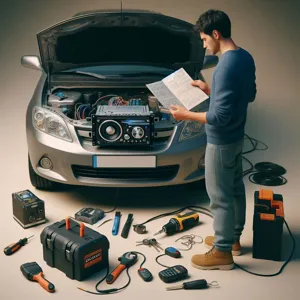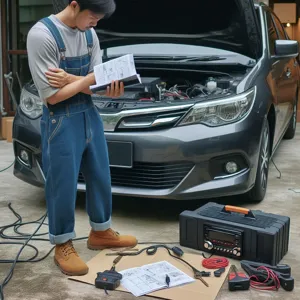Dealing with a car battery issue can be one of the most frustrating experiences for any driver.
Whether it’s a stubborn no-start situation, flickering lights, or strange sounds under the hood, a malfunctioning battery can quickly disrupt your day and leave you feeling stranded. However, with the right knowledge and tools, you can tackle these issues like a pro and regain control over your vehicle. In this comprehensive guide, we will walk you through ten essential steps to diagnose and resolve common car battery problems. From understanding the signs of battery failure to performing quick fixes and preventative maintenance, you’ll learn how to handle any battery-related challenge with confidence. Say goodbye to unexpected breakdowns and hello to smooth, worry-free driving!
1. Understanding Your Car Battery: Basics and Types

Understanding your car battery is the first step to resolving any battery-related issues like a pro. Your car battery is more than just a rectangular piece of hardware under the hood; it’s a crucial component that powers your vehicle’s electrical system, enabling everything from starting the engine to powering the radio and headlights.
At its core, a car battery is designed to store and deliver electrical energy. Most commonly, you’ll encounter lead-acid batteries, which come in two primary types: flooded and sealed (or AGM – Absorbent Glass Mat). Flooded batteries are the traditional option, often requiring periodic maintenance like topping off the fluid levels, while AGM batteries boast a sealed design that prevents spills and requires less upkeep, making them ideal for today’s high-performance vehicles.
In addition to these, there are lithium-ion batteries, which are becoming increasingly popular, particularly in electric vehicles. These batteries offer superior performance, lighter weight, and faster charging capabilities but come with a higher price tag. Understanding these types helps you choose the right one for your vehicle and its specific needs.
Moreover, familiarizing yourself with the battery’s components, such as terminals, casing, and electrolyte, will empower you to diagnose issues more effectively. Knowing how to read the battery’s voltage or interpret its age can give you essential insights into its health. Keep an eye out for signs of corrosion around the terminals or unusual swelling, as these can indicate underlying problems that may require attention.
Grasping the basics of your car battery not only prepares you for troubleshooting but also equips you to make informed decisions when it comes to replacements or upgrades. After all, a well-functioning battery is the heartbeat of your vehicle, ensuring you stay on the road with confidence.
2. Signs of a Failing Battery: How to Recognize the Symptoms
Recognizing the signs of a failing battery is crucial to avoiding inconvenient breakdowns and ensuring the longevity of your vehicle. A car battery typically has a lifespan of three to five years, but various factors can hasten its decline, including extreme temperatures, frequent short trips, and improper maintenance. Being attuned to the symptoms of battery distress can save you time, money, and headaches down the road.
One of the first indicators of a failing battery is sluggish engine cranking. If your engine takes longer than usual to start or you hear a slow, labored cranking noise, it’s a clear signal that your battery may be losing its charge. Additionally, dimming headlights and interior lights can indicate battery troubles; if you notice that your lights are flickering or appear dull, it’s time to investigate further.
Another sign to watch for is the check engine light on your dashboard. While this light can signify various issues, a failing battery is often among the culprits, particularly if it coincides with other symptoms. You should also keep an eye out for any corrosion buildup around the battery terminals, which can hinder performance and connection.
Lastly, pay attention to how often you need to jump-start your vehicle. If you find yourself frequently needing assistance to get your car going, your battery’s reliability is in question. By being proactive and recognizing these symptoms early, you can address battery issues before they leave you stranded, ensuring a smoother and more dependable driving experience.
3. Safety First: Essential Precautions Before Troubleshooting

When it comes to troubleshooting car battery issues, prioritizing safety is paramount. Working with batteries can be hazardous if proper precautions aren’t taken, so it’s essential to approach the task with care and diligence. Before diving into any troubleshooting, make sure to equip yourself with the right protective gear. Start with a sturdy pair of gloves to shield your hands from corrosive materials and a pair of safety goggles to protect your eyes from accidental splashes or sparks.
Next, ensure you’re working in a well-ventilated area. Fumes emitted from batteries, especially lead-acid types, can be toxic, and adequate airflow will help mitigate any risks. If you’re in a garage or enclosed space, consider opening doors or windows to enhance ventilation.
Always have a fire extinguisher nearby, ideally one rated for electrical fires, just in case things go awry. It’s also wise to keep a first aid kit on hand for minor injuries, as accidents can happen even to the most cautious.
Additionally, before you touch any components, make sure your vehicle is turned off and the keys are removed from the ignition. This not only reduces the risk of electrical shocks but also prevents unintended starts. If you’re working with a jump-start, ensure the donor vehicle is turned off before connecting the cables, and be mindful of the correct order of connection to avoid any short circuits.
Finally, familiarize yourself with your vehicle’s owner manual for specific instructions and safety warnings regarding the battery. By taking these precautions seriously, you’ll be setting yourself up for a safer and more effective troubleshooting experience, helping you address those battery issues like a true pro.
4. Gathering the Right Tools for Battery Maintenance
When it comes to resolving car battery issues effectively, having the right tools on hand is crucial. Think of gathering these tools as assembling your very own battery maintenance toolkit, designed to empower you to tackle any battery-related challenge with confidence.
Start with the basics: a set of safety goggles and gloves. These will protect you from any accidental spills of battery acid or debris, ensuring that your hands and eyes remain safe during the maintenance process. Next, you’ll need a reliable multimeter to measure the voltage of your battery. This handy device will help you determine whether your battery is charged and functioning properly or in need of a replacement.
A pair of insulated wrenches is essential for safely disconnecting and connecting battery terminals. These tools minimize the risk of short-circuiting while you’re working. Additionally, a battery terminal cleaner will help you remove corrosion that can hinder performance and connectivity. It’s a small investment that can make a significant difference, ensuring that your battery maintains a strong connection with your vehicle.
If you plan to jump-start a battery, don’t forget to include a set of jumper cables. Look for heavy-duty cables that can handle the voltage of your car’s battery and are long enough to reach another vehicle comfortably. Finally, consider a battery charger or maintainer for those times when your battery needs a little extra boost or when your vehicle will be sitting idle for an extended period.
By gathering these essential tools, you’ll be well-equipped to handle any battery maintenance or troubleshooting tasks, allowing you to resolve car battery issues like a pro. With the right preparation, you can not only save time and money but also gain the confidence to tackle battery problems head-on.
5. Step 1: Checking Battery Connections and Terminals

Before diving into any intricate battery troubles, the first step to resolving car battery issues is to check the battery connections and terminals. This foundational task is often overlooked, yet it can save you time, effort, and potentially costly repairs.
Begin by ensuring that your vehicle is turned off and parked in a safe, well-lit area. Open the hood and locate the battery, usually nestled snugly near the front of the engine compartment. Inspect the battery terminals, which are typically connected to two cables—one red for positive (+) and one black for negative (−). Look for any signs of corrosion, which can appear as a white, powdery substance around the terminals. Corrosion can impede the flow of electricity, leading to starting problems or intermittent power loss.
Next, check the tightness of the connections. Gently wiggle the cables; if they move easily, they may not be securely attached. using a wrench, carefully tighten any loose connections, ensuring not to overtighten, as this can damage the terminals. If you encounter corrosion, you can clean it using a mixture of baking soda and water. Apply the solution with a toothbrush or wire brush, making sure to scrub gently to avoid damaging the terminals. Once clean, rinse the area with water and dry it thoroughly.
After securing the connections, it’s a good idea to apply a thin layer of petroleum jelly or battery terminal protector spray to prevent future corrosion. This simple maintenance step can significantly extend the life of your battery and enhance its performance.
By starting with this straightforward yet crucial check, you can often solve battery issues before they escalate, ensuring that your car runs smoothly and efficiently. Remember, a little preventive care goes a long way in keeping your battery in prime condition!
6. Step 2: Testing Voltage with a Multimeter
Once you’ve safely accessed your car battery, the next crucial step is to test its voltage using a multimeter. This straightforward process can provide invaluable insights into the health of your battery, allowing you to diagnose potential issues before they escalate.
First, ensure you have a reliable digital multimeter at hand. If you’re unfamiliar with this handy device, it’s worth noting that it can measure both voltage and current, making it an indispensable tool for any DIY mechanic. To begin testing, set your multimeter to the DC voltage setting, typically indicated by a “V” with a straight line or a dotted line beneath it.
Next, carefully connect the multimeter’s black probe to the battery’s negative terminal and the red probe to the positive terminal. Make sure the connections are secure and that you’re not touching any metal parts with your hands, as this could affect the readings. Once connected, glance at the multimeter display to see the voltage reading. A healthy car battery should typically register between 12.4 to 12.7 volts when the engine is off. If the reading falls below 12.4 volts, it may indicate that your battery is weak or discharged.
If you want to take it a step further, perform the test while the engine is running. A voltage reading of around 13.7 to 14.7 volts indicates that your alternator is functioning properly and charging the battery. Conversely, if the voltage remains at or below 12.4 volts with the engine running, it could signal a failing alternator or another issue within the charging system.
Understanding these voltage readings is crucial for diagnosing your car battery’s health. If your tests indicate a problem, you’ll be better equipped to decide whether to recharge, replace, or seek professional help for your battery issues. Taking the time to test your battery with a multimeter puts you one step closer to resolving any battery-related challenges like a pro.
7. Step 3: Jump-Starting a Dead Battery: A Step-by-Step Guide

Jump-starting a dead battery is often a necessary skill for any vehicle owner, and doing it correctly can save you time and hassle when you’re stranded. Follow this step-by-step guide to ensure a safe and effective jump-start.
**1. Gather Your Equipment:** Before you begin, you’ll need a set of jumper cables and a functioning vehicle with a charged battery. Make sure both vehicles are turned off and parked close enough for the cables to reach both batteries.
**2. Position the Vehicles:** Park the working vehicle so that it is facing the dead vehicle. Ensure that both cars are in “Park” (for automatics) or in gear (for manuals) with the parking brakes engaged. This ensures safety while you work.
**3. Identify the Battery Terminals:** Open the hoods of both vehicles and locate the batteries. You’ll see two terminals on each battery: a positive (+) and a negative (–). It’s crucial to identify these clearly to avoid any mix-ups.
**4. Connect the Jumper Cables:** Begin by connecting one end of the red (positive) jumper cable to the positive terminal of the dead battery. Next, attach the other end of the red cable to the positive terminal of the working battery. Then, take the black (negative) jumper cable and connect one end to the negative terminal of the working battery. Finally, attach the other end of the black cable to a grounded metal surface on the dead vehicle, such as an unpainted bolt or bracket. This helps to prevent sparks near the battery.
**5. Start the Working Vehicle:** With the cables securely attached, start the engine of the working vehicle. Let it run for a few minutes. This allows your dead battery to absorb some charge from the working battery.
**6. Start the Dead Vehicle:** After a few minutes, attempt to start the vehicle with the dead battery. If it doesn’t start right away, wait a few more minutes before trying again. Patience is key, as the battery may need additional time to charge.
**7. Disconnect the Cables:** Once the dead vehicle starts, carefully disconnect the jumper cables in the reverse order of connection: first remove the black cable from the grounded surface of the dead vehicle, then from the negative terminal of the working battery. Next, remove the red cable from the working battery and finally the red cable from the previously dead battery.
**8. Let It Run:** Keep the revived vehicle running for at least 20 minutes to allow the alternator to recharge the battery fully.
By following these careful steps, not only do you ensure a successful jump-start, but you also minimize the risk of causing damage to either battery or the vehicles involved. Remember, if the vehicle doesn’t start after a few attempts, it may be time to consult a professional for further diagnosis.
8. Step 4: Cleaning Corroded Battery Terminals
**Step 4: Cleaning Corroded Battery Terminals**
One of the most common causes of battery issues stems from corrosion that builds up on the battery terminals. This unsightly residue, often appearing as a white, ashy substance, can hinder the electrical connection between your battery and the vehicle, leading to starting problems or even complete failure. Fortunately, cleaning corroded battery terminals is a straightforward process that can restore optimal performance to your car’s electrical system.
Before you begin, ensure you’re wearing protective gloves and goggles, as the corrosion can be harmful and the battery contains sulfuric acid. First, disconnect the battery cables, starting with the negative terminal followed by the positive. This precaution prevents any accidental short circuits while you work.
Once the cables are safely detached, assess the level of corrosion. For light corrosion, a simple mixture of baking soda and water can work wonders. Combine a couple of tablespoons of baking soda with a cup of water to create a paste. Use a toothbrush or a small wire brush to apply the mixture to the corroded terminals, scrubbing gently to remove the buildup. The alkaline properties of the baking soda neutralize the acid and dissolve the corrosion, making this method both effective and safe.
For more severe corrosion, you may need to employ a dedicated battery terminal cleaner, which can be found at most auto parts stores. These products are specially formulated to tackle tough corrosion and often come with a built-in brush for easy application.
After the terminals are clean, rinse the area with a small amount of water and dry them thoroughly. To prevent future corrosion, you can apply a thin layer of petroleum jelly or a commercial anti-corrosion spray to the terminals before reconnecting the battery cables. Finally, reattach the positive terminal first, followed by the negative, ensuring a snug fit.
By taking this simple yet essential step to clean your battery terminals, not only do you extend the life of your battery, but you also ensure your vehicle starts reliably every time. A clean connection is crucial for optimal performance, allowing you to hit the road with confidence. Plus, tackling this maintenance task on your own provides a sense of accomplishment, reinforcing your growing expertise in resolving car battery issues like a pro.
9. Step 5: Inspecting for Leaks and Damage
When it comes to ensuring the longevity and optimal performance of your car battery, a thorough inspection for leaks and damage is an essential step that should never be overlooked. Begin by visually examining the battery casing for any signs of cracks, bulges, or corrosion. A healthy battery should have a smooth, intact surface; any irregularities could indicate internal damage or a potential failure.
Next, pay close attention to the battery terminals. These are often the first places to show signs of wear and tear. Look for any buildup of white, crusty corrosion around the terminals, which can hinder the electrical connection and lead to starting issues. If you spot corrosion, it’s important to clean it off using a mixture of baking soda and water, but remember to wear gloves and goggles for safety!
Furthermore, inspect the area around the battery for any signs of fluid leaks. This can be particularly telling; a leak may suggest that the battery is overcharging or that the electrolyte levels are dangerously low. If you discover any fluid pooling or dripping, it’s crucial to address the issue immediately, as battery acid can be harmful to both your vehicle and the environment.
Additionally, if your battery is of the lead-acid variety, check the electrolyte levels through the inspection windows (if available) or by removing the caps. A low electrolyte level can lead to decreased performance and a shortened lifespan. If the levels are low, top them up with distilled water, but be cautious not to overfill.
By diligently inspecting for leaks and damage, you give yourself the best chance of preventing unexpected breakdowns and prolonging the life of your battery. Remember, a well-cared-for battery is not just a matter of convenience; it’s an investment in the reliability and efficiency of your vehicle.
10. Step 6: Understanding Battery Life Expectancy
Understanding battery life expectancy is crucial for any car owner striving to maintain their vehicle’s reliability and performance. Car batteries are not designed to last forever; in fact, most batteries have an average lifespan of three to five years, depending on various factors such as usage, climate, and maintenance.
To gauge your battery’s health, it’s essential to recognize the signs of aging. A battery may begin to show its age through sluggish engine starts, dimming headlights, or a flickering dashboard. Additionally, extreme temperatures can significantly affect battery performance. In colder climates, for instance, the battery works harder to start the engine, while excessive heat can accelerate the degradation of battery components.
To make the most of your battery’s life, regular maintenance is key. This includes checking battery terminals for corrosion, ensuring the battery is securely mounted, and testing the charge regularly with a multimeter or battery tester. Many auto parts stores offer free battery checks, providing a quick assessment of your battery’s current condition.
Moreover, always keep an eye on your vehicle’s behavior; if you notice any unusual signs, such as frequent jump-starts or electrical issues, it may be time for a replacement. By understanding the life expectancy and health of your car battery, you can take proactive measures to avoid being stranded and ensure that your vehicle runs smoothly for years to come. By staying informed and attentive, you’ll not only extend your battery’s life but also enhance your overall driving experience.
11. Step 7: When to Recharge vs. Replace Your Battery
Determining whether to recharge or replace your car battery can be a tricky decision that many drivers face. The key lies in understanding the symptoms of battery failure and evaluating the battery’s overall condition.
If your battery is sluggish or your car struggles to start, it may simply need a good recharge. Often, short trips and cold weather can drain a battery, making it seem weaker than it is. In these cases, a simple jump-start followed by a longer drive may be all you need to rejuvenate the battery and restore its performance. Regularly recharging your battery, especially during periods of infrequent use, can extend its lifespan significantly.
However, if you find yourself frequently needing to recharge or jump-start your vehicle, it may be time to consider a replacement. A battery that is more than three to five years old is especially prone to failure, as its capacity diminishes over time. Additionally, if you notice any swelling or leakage, it’s a clear indication that the battery has reached its end of life and should be replaced immediately for safety reasons.
To make an informed decision, you can also perform a load test or have a professional technician check the battery’s health. Many auto parts stores offer free battery testing, allowing you to determine whether it’s still viable or ready for retirement. Remember, a reliable battery is essential not just for starting your car but also for the overall function of your vehicle’s electrical system. Being proactive about knowing when to recharge versus replace can save you from inconvenient breakdowns and keep you on the road with confidence.
12. Step 8: Properly Installing a New Battery
Installing a new car battery may seem straightforward, but doing it correctly is essential for the longevity of both the battery and your vehicle’s electrical system. First, ensure you have the right tools at hand: a socket wrench, safety goggles, and gloves. Safety should always be your top priority when dealing with batteries, as they contain corrosive acid and can emit harmful gases.
Start by preparing your vehicle. Turn off the engine and remove the keys from the ignition. Open the hood and locate the battery; if it’s secured with brackets or covers, remove them carefully. Before you disconnect the old battery, take a moment to identify the positive (+) and negative (−) terminals. It’s crucial to disconnect the negative terminal first to prevent any electrical shorts.
Once the old battery is out, inspect the battery tray for signs of corrosion or dirt. Clean it thoroughly using a mixture of baking soda and water to neutralize any acid residue. This step is often overlooked, but a clean tray will ensure a good connection and prevent future issues.
Now, it’s time to install the new battery. Carefully place it in the tray, ensuring that the positive and negative terminals are correctly aligned with the corresponding cables. Once in position, connect the positive terminal first, followed by the negative terminal. Make sure the connections are tight and secure to prevent any movement or disconnection while driving.
Finally, double-check your work by ensuring that the battery is seated properly and that all connections are secure. Replace any brackets or covers you removed earlier, and close the hood. Starting your vehicle should now be a smooth process, and you’ll be back on the road with confidence, knowing your new battery is installed correctly. Following these steps not only helps avoid potential issues but also enhances the overall performance of your vehicle.
13. Step 9: Programming Your Car’s Electronics After Battery Replacement
After successfully replacing your car battery, the next crucial step is programming your car’s electronics. Modern vehicles are equipped with complex electronic systems that rely on a stable power supply to function correctly. When you disconnect the battery, these systems can sometimes lose their settings, leading to various issues, such as malfunctioning displays, loss of radio presets, or even trouble with the engine control module.
To start the programming process, first, reinsert the key into the ignition and turn it to the “on” position without starting the engine. This allows the vehicle’s computer to recognize the new battery and begin recalibrating its systems. Depending on your vehicle, you may need to follow specific procedures outlined in your owner’s manual. For some models, this might mean pressing a sequence of buttons or navigating through the vehicle’s menu settings.
One common area that often requires reprogramming is the radio or infotainment system. You might find that your favorite stations or personalized settings have vanished. Simply re-enter your presets and check that all features are functioning as expected. Additionally, if your car has a keyless entry system, you’ll want to ensure it’s operating smoothly. Sometimes, reprogramming your key fob may be necessary to sync it with the new battery.
Lastly, don’t forget to check the vehicle’s warning lights on the dashboard. If any remain illuminated, it could indicate that something didn’t reset properly or that further diagnostics are necessary. Taking the time to program your car’s electronics after a battery replacement not only ensures that all systems are running seamlessly but also helps prevent potential headaches down the road. By following this step diligently, you’re one step closer to enjoying a smoothly running vehicle once again.
14. Step 10: Regular Maintenance Tips to Prevent Future Issues
Once you’ve successfully tackled your car battery issues, the next crucial step is to implement regular maintenance practices to ensure that your battery remains in peak condition and to prevent future problems. Just like any other component of your vehicle, a little proactive care can go a long way in extending the life of your battery and enhancing your overall driving experience.
Start by checking your battery’s terminals regularly. Look for signs of corrosion, which can appear as a white, powdery substance around the terminals. If you notice any buildup, clean it off with a mixture of baking soda and water, using a brush or cloth to scrub away the grime. This simple step can significantly improve the battery’s connection to the vehicle, ensuring optimal performance.
Next, consider the climate in which you live. Extreme temperatures—whether hot or cold—can put extra strain on your battery. If you live in an area with sweltering summers, parking your vehicle in a shaded area can help prevent overheating. Conversely, in colder climates, consider using a battery warmer during frigid months to keep the battery at an ideal operating temperature.
Additionally, make it a habit to check the battery’s charge level. Many modern vehicles are equipped with a battery management system that provides this information, but for older models, you can use a multimeter to measure the voltage. Ideally, your battery should read around 12.6 volts when fully charged. If it consistently drops below this level, it might be time to consider a replacement.
Lastly, remember that batteries are not meant to last forever. Most car batteries have a lifespan of about three to five years. Keep track of when your battery was installed and schedule a replacement before it becomes a problem. This proactive approach not only saves you from being stranded but also contributes to the overall efficiency of your vehicle.
By following these regular maintenance tips, you can ensure that your car battery remains reliable and effective, preventing the headaches of unexpected failures and keeping you on the road with confidence.
15. Conclusion: Knowing When to Seek Professional Help
As we wrap up this guide on resolving car battery issues, it’s vital to emphasize the importance of knowing when to call in the professionals. While many battery problems can be diagnosed and addressed with a bit of DIY knowledge and the right tools, some situations demand the expertise of a trained technician. If you find yourself facing persistent issues despite your best efforts, it may be time to seek professional help.
For instance, if your battery repeatedly dies even after a jump-start or replacement, it could signal deeper electrical problems, such as a faulty alternator or a parasitic drain. These issues often require specialized diagnostic equipment and experience to identify and resolve effectively. Additionally, if you feel uncomfortable working with electrical components or lack the necessary tools, don’t hesitate to reach out to a professional.
The peace of mind that comes with expert assistance can save you time, money, and potential hazards. Remember, your safety is paramount, and a qualified mechanic can ensure that your vehicle is not only running smoothly but is also safe to drive. So, while you now have the knowledge to troubleshoot and manage battery issues like a pro, don’t overlook the value of professional support when needed. Your car—and your peace of mind—will thank you.
In conclusion, we hope this guide on resolving car battery issues has equipped you with the essential knowledge to tackle any battery-related challenges like a pro. By following these ten steps, you’ll not only be able to diagnose and address common battery problems with confidence but also extend the life of your battery and optimize your vehicle’s performance. Remember, regular maintenance and awareness of your car’s needs can save you time, money, and frustration in the long run. So, the next time you encounter a battery issue, you’ll be ready to roll up your sleeves and get to work. Safe travels, and may your journeys be powered by a reliable battery!




































